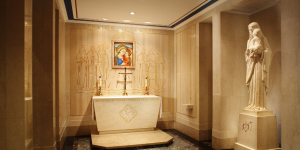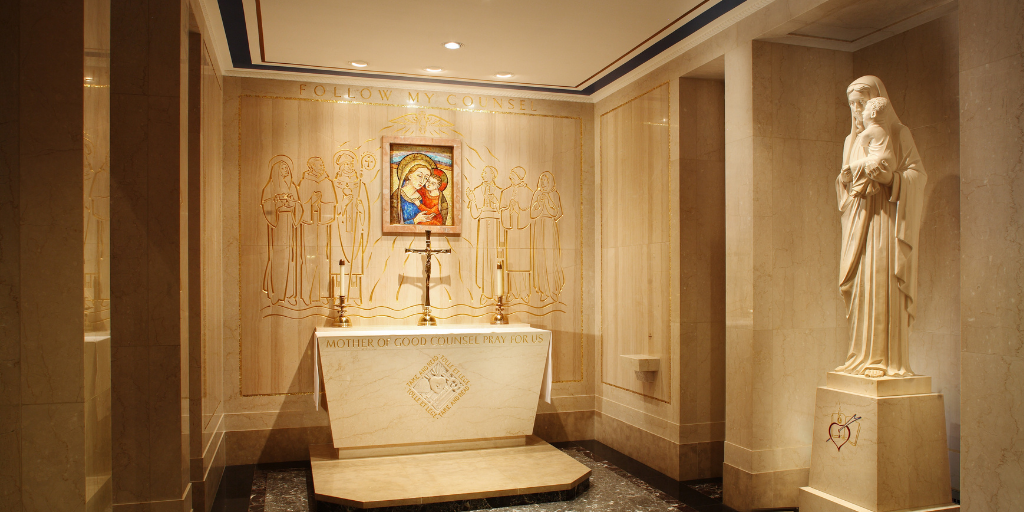
With over 80 chapels and oratories located throughout its marble halls, the Basilica offers a plethora of places to seek God and contemplate His grace. Honoring Marian traditions from around the world, these spaces were designed to encourage and inspire visitors as they reflect on Our Lady’s example of faithfulness.
Today, we invite you to discover three Marian chapels and oratories with dedication anniversaries this month.
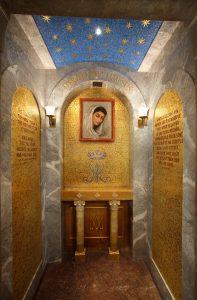
The Our Lady of Ephesus Oratory in the Crypt Church
Dedicated on April 4, 2003, the Our Lady of Ephesus Oratory at the Basilica features an elegant mosaic of the Blessed Mother surrounded by gold tiles and a shimmering blue ceiling dotted with golden stars. A gift of the American Society of Ephesus, the oratory was designed and installed by Rambusch Decorating Co.
The devotion to Our Lady of Ephesus was inspired by Mary’s role in the early development of the Church. According to Catholic tradition, after Christ was crucified, Mary lived with John in his home at Ephesus (modern day Turkey). During her time there, the Blessed Mother helped nurture the early Church through her encouragement, prayers, and intercession. Later, in A.D. 431, at the Council of Ephesus, the Church formally recognized Mary’s role, declaring her to be the Theotokos – “the God bearer.” The first church dedicated to Our Lady was built at Ephesus in the second century. Centuries later in 1891, a group of Catholic priests discovered the Ephesian home and identified it as the place where Mary spent the last years of her earthly life. Today, the house has been restored and is a popular pilgrimage site for Christians.
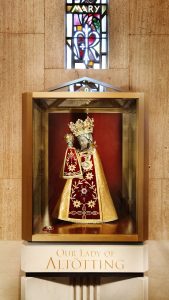
The Our Lady of Altötting Oratory in the Great Upper Church
This April marks the 20th anniversary of the dedication of the Our Lady of Altötting Oratory at the National Shrine. Hand carved from Lindenwood, the oratory’s statue is 25 inches tall and is clad in traditional Bavarian baroque style robes, handmade by Cistercian nuns. At the Basilica, it is displayed with a bride’s rosary of coral and silver filigrees. To the left of the statue is a depiction of St. Conrad of Parzham, the “Doorkeeper of Altötting,” just like at the Shrine in Altötting.
The devotion of Our Lady of Altötting dates back to the 14th century and comes from the German region of Bavaria. During World War II, craftsman Josef Neustifter of Eggenfelden, Bavaria, carved an exact copy of the statue to reside in the Holy Chapel in Altötting while the original was hidden in a safe location. After the war, the original statue was returned to its place. Neustitfter made an additional four replicas, one of which now resides at the Basilica.
Our Lady of Altötting has a special tie to Pope Benedict XVI, as he was born just outside Altötting and frequently visited the shrine there. On April 16, 2005, Pope Benedict’s birthday, the Our Lady of Altötting Oratory was dedicated at the National Shrine – a mere three days before he was elected Successor of St. Peter. During his visit to the Basilica in 2008, he also spent time praying at the Oratory on the third anniversary of its dedication.
The Our Mother of Good Counsel Chapel in Memorial Hall
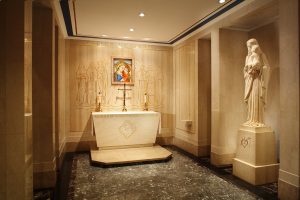
60 years ago, on April 26, 1965, the Our Mother of Good Counsel Chapel was dedicated at the National Shrine.
Dating to the 15th century, the tradition of Our Mother of Good Counsel began during the Turkish offensive in Albania, when the church of Scutari was destroyed and a fresco of the Madonna and Child went missing. Tradition holds that, later that year, in Genazanno, Italy, the faithful were celebrating the feast of St. Mark when they heard ethereal music, a cloud descended, and all the bells of the town began to ring. When the cloud dissipated, the fresco was standing on an unfinished wall of the church on a slim piece of plaster. After its migration, the fresco remained intact for many years, even surviving the assault on the building during World War II, and came to be known as Our Mother of Good Counsel.
In the Our Mother of Good Counsel Chapel at the Basilica, the fresco’s image is replicated in intricate mosaic tiles. This type of portrayal of Mary is known as Eleousa (Tender Touch), with Mary depicted in a gentle, intimate pose, embracing the Christ Child. Surrounding the mosaic are depictions of men and women who were devoted to Our Mother of Good Counsel, including St. Rita of Cascia, Blessed Stephen Bellesini, St. Augustine, Pope Leo XIII, Pope Paul II, and Petruccia dei Nocera. Carved into the altar is the Augustinian seal of the burning heart, mitre, and crosier, with the command “Take and Read.” To the right of the altar, Our Mother of Good Counsel is sculpted in Trani marble.
Sources:
Rohling, Geraldine M., PhD, MAEd. The Basilica of the National Shrine of the Immaculate Conception: Guide and Tour Book. Washington, D.C.: Basilica of the National Shrine of the Immaculate Conception, 2018.
Light a Candle at the Basilica
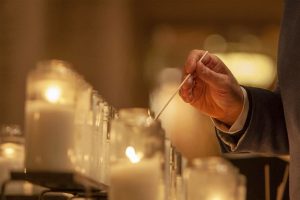 In honor of the Blessed Mother, we invite you to light a candle today at the National Shrine. Vigil candles burn in the chapels throughout the Great Upper Church and lower crypt level of the National Shrine. Each candle represents the faith of the supplicants and their fervent prayers entrusted to the loving intercession of the Blessed Mother.
In honor of the Blessed Mother, we invite you to light a candle today at the National Shrine. Vigil candles burn in the chapels throughout the Great Upper Church and lower crypt level of the National Shrine. Each candle represents the faith of the supplicants and their fervent prayers entrusted to the loving intercession of the Blessed Mother.

